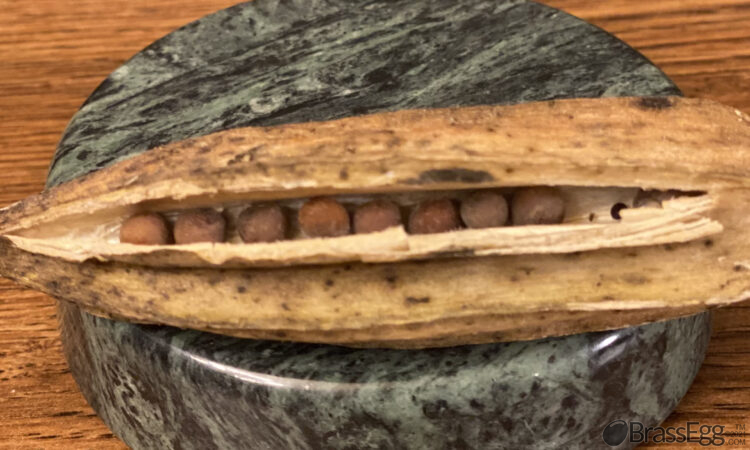Like many vegetables, the germination rate (percentage of seeds that actually sprout) and the vigor (how strong each seedling grows to be) of an okra seed is improved if it is allowed to fully mature on the ‘vine’. Okra is best left on the stalk/vine until the seed pods dry out so much that they begin to split on their own and spill out.

Most importantly, you must purchase Heirloom seeds from the beginning if you want to be able to collect viable seeds for the next year. Heirloom seeds will say so on the packet, and sometimes are more expensive, but certainly worth it. This year we planted some Hill Country Red Okra which is an Heirloom out of South Texas. If the packet doesn’t say “Heirloom” on it somewhere then you should assume it is a much cheaper hybrid which will grow fine for you the first year, but it’s seeds will not reproduce like the original. It’s fine to grow hybrids, but there really is a thrill to saving your seeds and planting them the next year. A gardener’s version of being a grandparent!

The kids randomly planted seeds around the construction site having no idea what might actually grow. One of the Okra got a foot-hold in the clay and even though it was planted in heavy shade too late in the summer, it was able to bring one seed pod on. I didn’t discover it until I got really good at using my hands free crutch. One seed pod isn’t enough to bother cooking, plus it was far too mature to eat. This is actually a blessing after all, we now have an Okra that survived zone 5!

One month later in early November it had dried out and all the leaves had fallen off. Perhaps I should have let this seed pod remain on the plant for a few more weeks to allow it begin to crack open on it’s own. The plant was in the area I was planning to move the coop too though, so I had to pick it. 44 seeds came out of this one pod. Only 1 was clearly not viable, you can tell from the shriveled shape of the small seed on the closest edge of the paperweight. The rest appear to be fine until….

Opening the original seed packet reveals that the commercial seeds all have a dark slate coloring. In comparison my 2020 Zone 5 Okra seeds look brown and immature. This could be a cosmetic preference of the seed seller, a slight variation my plant created to survive the cooler weather, or maybe they are not fully mature. I won’t know until next year when they start coming up out of the ground. Can’t wait to compare my 2020 Zone 5 to the original South Texas Heirloom!

Okra is a Southern Side dish I don’t see often now that I’ve moved North. If you get a helping of it up here, it was likely raised in India and shipped over. If you want to do a deep dive on the subject, there is an entire book on Okra! There are lots of reasons to grow it as a new gardener, the biggest being that deer and other wildlife won’t mess with it. The stalks and leaves are so prickly that my mom would wear long sleeves and gloves….but she was harvesting a full row at a time. For the absolute best taste, harvest only the best immature okra to make up for supper that
night. If you see mature seed pods let them go and harvest them for seed later. The flavor goes downhill rapidly after the first day they’ve been picked, so only harvest a bunch at one time if you plan to prep and freeze them by bedtime.

A second good reason to start out with Okra is because it doesn’t require irrigation and likes well-drained soil. I like it as a “border crop” to create an unpleasant barrier for foraging animals. You can also use it to expand your garden planting area by using a part of the garden that the sprinkler won’t reach or in an area that you are just beginning to improve the soil.
Brass Egg™ participates in affiliate marketing programs, and may receive compensation when you click and purchase from links to retailers. Brass Egg™ of Russell Holdings Group, LLC 2021. All content ©2021 Russell Illinois Holdings, LLC. All Rights Reserved.


